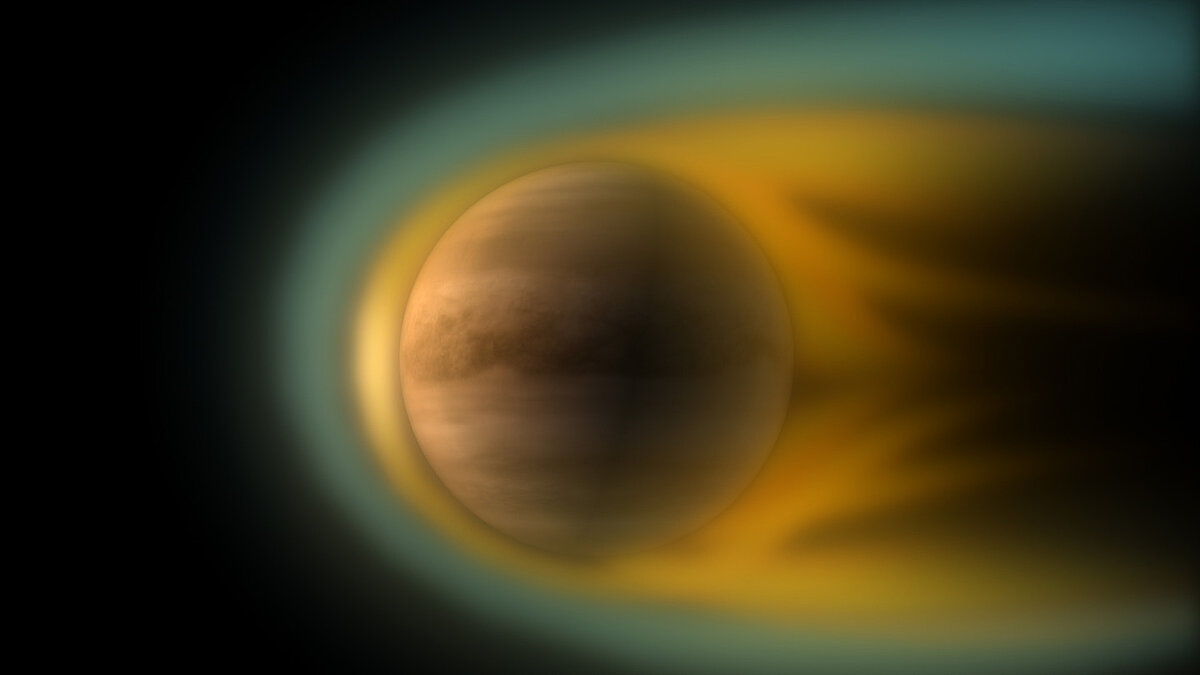Unlike Earth, our neighboring planet Venus does not have its own magnetic field. Therefore, the stream of particles emanating from the Sun, also known as the solar wind, directly interacts with Venus' atmosphere and accelerates charged particles, which can then escape into space. Previous measurements from space probes such as Venus Express have already shown that these ions are mainly composed of oxygen and hydrogen. However, the mass resolution of the instruments used at that time was not sufficient to distinguish between carbon, nitrogen, and oxygen.
The BepiColombo probe flies near Venus
On its way to Mercury, the BepiColombo space probe will need flybys around Earth, Venus and Mercury itself as well as a solar-powered electric propulsion system so it can eventually swing around in Mercury's orbit against the Sun's powerful gravity. On August 10, 2021, the spacecraft flew by Venus for the second and final time, just one day after Solar Orbiter.
On this occasion, BepiColombo approached to a distance of 552 kilometers from the surface of the planet. Many of the instruments on board were active during the flyby, collecting unique data from Venus' environment. Among other things, the ion mass spectrometer detected a stream of low-energy carbon and oxygen ions. “Magnetic field measurements showed that these particles must come from Venus’ magnetosphere,” says co-author David Fischer, a member of the magnetometer group at the Institute for Space Research at the Austrian Academy of Sciences (ÖAW).
The detection of this stream of particles provides important information about the composition and dynamics of Venus' magnetosphere and could also help explain the past and future evolution of its atmosphere. The planet's escaping electrons create an electric field that pulls in carbon and oxygen ions and expels them from Venus' atmosphere.
On board Pepe Colombo
The BepiColombo dual spacecraft is a collaboration between the European Space Agency (ESA) and the Japanese space agency JAXA. The OeAW Institute for Space Research is involved, among other things, in the magnetic field measuring instruments on both space probes – Mio (Magnetospheric Orbit) and MPO (Planetary Orbit). Contributions were funded by the FFG Research Funding Agency.
“It's good that years of intense work on our magnetometers are already paying off before BepiColombo reaches its destination. I'm very excited, in collaboration with scientists at the Institute, to see what the instruments will discover about Mercury's magnetosphere and interior,” says David Fisher.
“These measurements from BepiColombo during the flyby of Venus will allow our scientists to learn more about the processes that control the evolution of planetary atmospheres, their magnetospheres and their interaction with the solar wind – both in our solar system and in extrasolar systems,” says Christiane Helling, director of several research groups. Space Research Institute at ÖAW: “At the institute they are dedicated to study.”
Why is space research important?
The dual BepiColombo spacecraft was launched on October 20, 2018 and is on a seven-year journey to the smallest and least explored terrestrial planet in our solar system. When it reaches Mercury at the end of 2025, the high-tech instruments on board will collect highly accurate data for at least a year, despite temperatures of more than 350 degrees Celsius, which it eagerly awaits on Earth.
Mercury is the only planet in the solar system that, like Earth, has a solid surface and creates a magnetic field with a liquid core inside. This magnetic field and its influence on the solar wind are precisely measured using the measuring instruments of the two BepiColombo satellites in order to examine the internal structure of Mercury and explore the differences and similarities with the Earth's core and thus better understand the internal structure of our home. Planet Earth.

“Social media evangelist. Baconaholic. Devoted reader. Twitter scholar. Avid coffee trailblazer.”







More Stories
Azimut Yachts Water Boat Show (10.5.24 Sibenik)
European Space Agency image showing “traces of spiders on Mars”
Resident Evil 9: Release will likely be delayed internally, insiders say